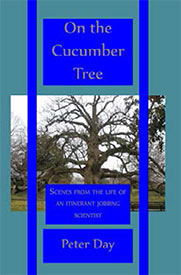On the Cucumber Tree: Scenes from the Life of an Itinerant Jobbing Scientist
By Peter Day, Glasgow: The Grimsay Press, 2012, 236 pp., $19.95 (paperback)
Reviewed by Robert P. Crease

Day’s research, which is officially classified as chemistry though it has a strong physics component, included pioneering the study of mixed-valence compounds. His administration included directorship of the Institut Laue-Langevin (ILL; 1989-91) and directorship of the Royal Institution (1991-1998).
The curious title refers to the Hungarian expression az uborkafan, which was used by H. S. Hoff, another British science administrator—under the pen name William Cooper—in the novel Memoirs of a New Man. Hoff translated the expression literally as “on the make” or “on the climb,” characterizing it as an image “of lasting poetry for a human occupation equally lasting and poetic.”
Day appropriates the image for his own street-level perspective on what it was like to pursue a scientific career. In truth, he wound up in several interconnected cucumber trees. One was the Oxford academic community of the 1960s and 1970s, another the international, interdisciplinary scientific community, and yet a third consisted of a network of scientific institutions and the administrators who run them.
Day’s writing is disarmingly casual. In early chapters he tells us what it was like to be a teenager, for whom “all the world looks fascinating,” who was ini-tially attracted to physics. “[T]he sweep of its intellectual ambitions” seemed overwhelming, Day writes, especially since “first things and last things are, after all, the bedrock of adolescent angst.” Assigned to explain an optical spectroscope to a distinguished visitor (Neville Mott), Day became captivated by the instrument, and his interests then veered towards chemistry.
Day ended up at Wadham College, Oxford, as an undergraduate, and remained there for graduate work. He provides often compelling descriptions of its rituals and personalities, not only of the strong but also of the weak ones: “[S]o wrapped up were they in the fine detail of their expertise that they were quite unable to imagine themselves in the situation of someone who wanted, even yearned, to have that door opened but needed help in lifting the latch”.
Here’s Day on what it’s like to pick a good research topic: “[P]retty much like picking an opponent your own size in a boxing match. Too light-weight and the game is soon over but the win trivial; too weighty and you risk retiring hurt after a lot of effort and little to show for it.”
He relates his growing attraction to mixed valence compounds, and his 1966 visit to Bell Labs in Murray Hill to work with Melvin Robin. That collaboration culminated in an important contribution, the Robin-Day classification of mixed valence compounds. But Day also writes of hurt feelings on Robin’s part over credit for that work, and relates that the two ended up no longer communicating.
Day became Assistant Director of the ILL in 1988, then Director the following year; that part of the climb involved him in things like negotiating with the union and with “events;” defects in the reactor requiring its shutdown. From there he moved on to become Director of the Royal Institution.
The chapters are mostly short, the anecdotes mostly interesting, and the book has numerous black and white pictures. The book costs less than $20, and can be read on a long train trip. A historian will find many details about the grain of today’s scientific life that are usually passed over in more formal or ambitious histories and biographies. We could use many more tales from the cucumber tree like this one.
The articles in this issue represent the views of their authors and are not necessarily those of the Forum or APS.
